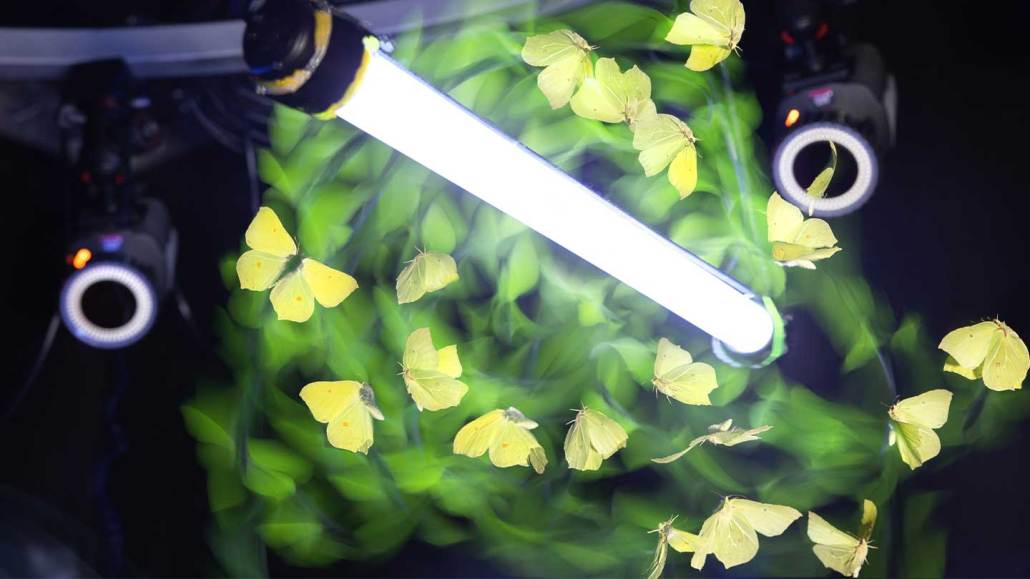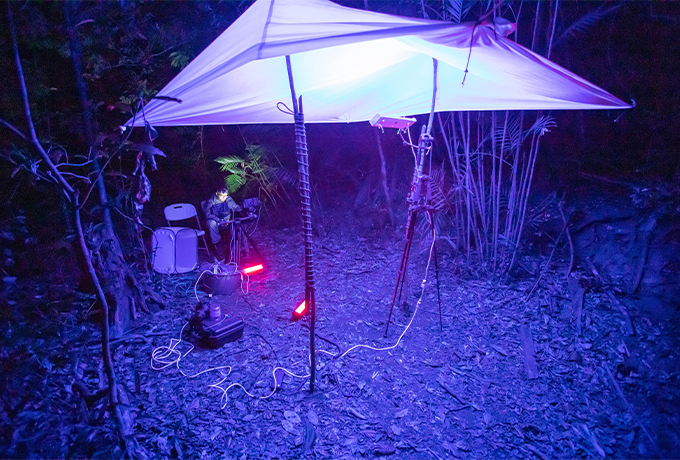Which way is up? Insects may lose track near artificial lights
Trying to keep the light at their backs may send flying bugs topsy-turvy, high-speed video shows

A brimstone butterfly (Gonepteryx rhamni) is shown in multiple locations using motion-capture. The insect appears to try to keep its back toward a tube light as it flits around. This may explain why flying insects seem to lose their sense of direction around artificial lights.
Thomas Angus
Share this:
- Share via email (Opens in new window) Email
- Click to share on Facebook (Opens in new window) Facebook
- Click to share on X (Opens in new window) X
- Click to share on Pinterest (Opens in new window) Pinterest
- Click to share on Reddit (Opens in new window) Reddit
- Share to Google Classroom (Opens in new window) Google Classroom
- Click to print (Opens in new window) Print
People have long watched moths and other flying insects flock to streetlamps, porch lights and flames. These insects appear captivated by the light. But new data suggest they may just lose track of which way is up.
Insects naturally turn their backs toward light. But when that light is from an artificial source, it may send their sense of direction topsy-turvy. If they lose track of where the ground is, insects can end up flying in circles or diving toward the ground.
That’s the conclusion of a new study. Its findings appeared January 30 in Nature Communications.
This result is the first “satisfying answer” as to why insects collect around lights at night, says Florian Altermatt. An evolutionary biologist, he works at the University of Zurich in Switzerland. He did not take part in the new study. “It was also interesting to see that it was an actually rather simple explanation, defying the previous, more complex ones.”
There have been lots of those previous hypotheses. Maybe light blinds flying insects so that they get trapped by the light. Or maybe they interpret light at night as a place to fly for a quick escape. Another idea suggests that the light of the moon serves as a compass. If nocturnal insects mistakenly use artificial lights to navigate, the results could turn deadly.
The new study suggests flying insects instead turn their backs to the sky’s light to keep their feet pointing toward the ground. “It’s a really good idea until somebody invents the LED,” says Samuel Fabian, who led the new study. Then, suddenly, “it’s a very bad idea.” Fabian is an entomologist, someone who studies insects. He works at Imperial College London in England.
Flight patterns
Fabian was part of a team that tracked how artificial light affects insect flight. At a field station in Costa Rica, they set up hanging and standing lights. Then they used high-speed infrared cameras to track wild, flying insects. These included moths and flies.
Some circled the lights endlessly. Others flew steeply upward, losing speed until they couldn’t fly any higher. When the light source pointed up, some bugs flipped over and headed for the ground.
During flight, the insects always kept the lights at their back. They did so even if they would end up crashing.
The results “didn’t fit with any of the theories that had been proposed before,” notes coauthor Yash Sondhi. He’s an evolutionary biologist at the McGuire Center for Lepidoptera and Biodiversity. It’s part of the Florida Museum of Natural History in Gainesville. The insects weren’t flying toward the light, these data indicate. That’s what you would expect if light signaled an escape route. Nor were they flying in smooth spirals, which would suggest the light acted as a compass.
Instead, “it’s a bit like somebody’s grabbed [a pilot’s] joystick and is pulling it in the wrong direction,” Fabian says.
The team tried different lighting to further explore the effect.
Insects flew normally when a sky-like artificial light was placed opposite to the ground. Crash landings were common when the team lit up a white sheet on the floor. But not when a white sheet — stretched into a canopy above the floor — was bathed in diffuse light, much as the sky would be. Then, insects flew through the area without getting trapped by the light.
The team also observed some species in a lab. Moths and dragonflies generally behaved like the wild insects. They kept the light at their backs. But there were some exceptions.
Fruit flies — which can fly in the dark — weren’t strongly affected by the light. In the lab, oleander hawk moths could fly over ultraviolet or LED lights without being thrown off course. In the wild, though, the moths still crashed.

It’s unclear why, Sondhi says. Maybe the insects can sometimes suppress their response to light. Or, over time, they might learn to avoid artificial light.
Brett Seymoure is an animal and visual ecologist at the University of Texas at El Paso. Overall, he says, it’s clear that light at night can put insects on a crash course. But it will take more research to figure out why. For one, it’s important to know if insects use the sky’s light (artificial or not) for navigation.
Seymoure didn’t take part in the new study. But he’s teaming up with Sondhi and others to explore other open questions. One is whether insects at different latitudes are more or less sensitive to light pollution. Another is whether outdoor lights can be altered to make them less attractive to flying insects.
Now knowing why moths are flying to these lights, “we can now better design light fixtures that will make it so that they’re not actually doing this,” Seymoure says.







